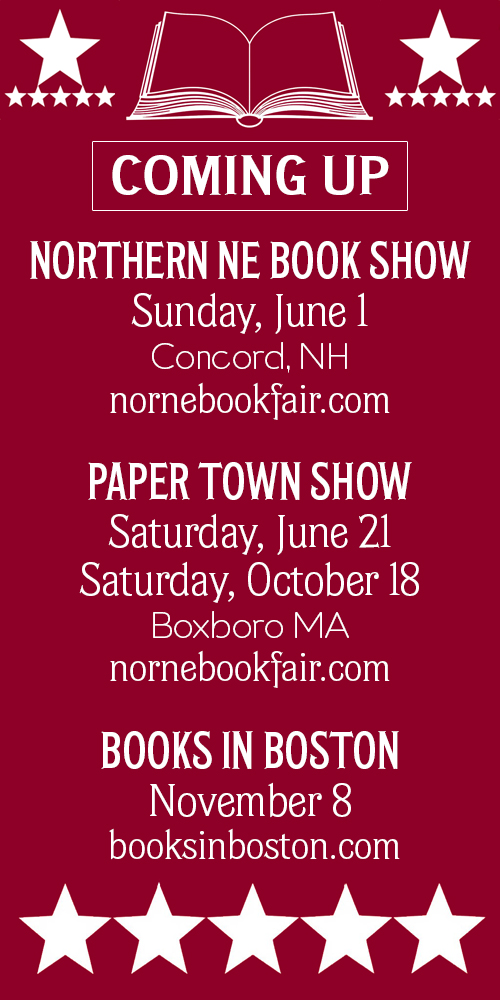A Summer Salmagundi
In the more than 26 years years of publishing this magazine I can’t remember when we’ve had more response from our readers – this time enthusiastically favorable. Anthony Marshall’s A Slow Bookshop hinted at a watershed of sorts – it continues to rain books, in every format imaginable, but at some point in the future, and I have no idea when, nearly all booksellers could be in the rare book business for the simple reason that books made from paper, boards and cloth may become increasingly rare.
Even though the book is basically a convenient and low-maintenance bundle of paper that we use to read and preserve printed words – throughout the centuries fine binders, illustrators and fore-edge painters have gilded the lily with every embellishment imaginable. As objects with both utilitarian and artistic qualities, books allow their owners to have their cake and eat it too. Or should that be the other way around?
In any event, as the market for digital downloads continues to increase – especially for the flood of ghost-written “celebrity” books that crowd the best seller lists, I find myself in agreement with Mr. Marshall’s sentiments – “No doubt many people will switch to e-books... if this means that there will be fewer books, I mean books as physical printed objects, then that can only be a good thing... the world is swamped with books, most of which we secondhand booksellers could very well do without... I am confident there will be enough printed books to keep all the slow bookshops in the world going for decades to come...”
Books represent but one example of manufactured goods that are useful, durable and also, in my opinion, aesthetically appealing. There are plenty of others. Flatware (knives, forks and spoons) is what most of us use at dinner-time, and whether made from sterling silver, silver plate, stainless steel or plastic – all of it will suit the purpose just fine. Plastic usually gets tossed in the trash bin, most stainless steel or silver plate eventually ends up in a garage sale, but sterling is often handed down from generation to generation (or sold to a gold-and-silver buyer set up in a motel or strip mall near you). A sign in front of a display of flatware at an antique show last year summed it up – “The Mathematics of Fine Dining: plastic < stainless steel < silver plate < sterling silver”.
I suppose the same thing could be said when comparing fine porcelain china with plates, cups and saucers for everyday use – the Queen undoubtedly knows how to set a grand table for her state dinners at Windsor, but legend has it that when dining alone she’s been known to use Tupperware. There’s really no argument here – as in most areas of living there are lots of options to choose from and, in my opinion, having a choice is usually a good thing.
I’ll admit that the previous examples and comparisons are a bit of a stretch, and except for the attrition factor, that’s about as far as I’m willing to go. But every time there’s a run on precious metals more sterling flatware gets sent to the smelter, contributing to the scarcity of the older and more desirable patterns.
I think there are similar forces at work that will eventually strengthen the antiquarian and rare book market. As a natural-born contrarian, my normal instincts are to figure out where the masses are off to and then head in the opposite direction, so when I recently saw a television advertisement for a company selling audio books, I paid attention. The voice of a young woman sounding twenty or thirty IQ points short of a valley girl says “my grandmother listens to books...” and I immediately start thinking about supply and demand. More publishing-on-demand, increased sales of audio or electronic books, and the continued pulping of unsaleable books by organizers of library and charity book sales (judging by what happens locally) should eventually contribute to the overall scarcity of traditional paper-and-cloth books. Fast forward a few decades and more antiquarian bookshops may resemble our more up-market art or antique galleries – where physical books may be exhibited and offered for sale as collectible artifacts from a not-so-distant past. That they will still be readable, useful and not in need of a charger or new batteries is the important part – everything else is just icing.
*
About a week ago I fished another book, practically begging to be read, from one of the stacks next to my “prime-time” reading chair – sorry NBC, CBS, ABC, etc.
It’s been more than a year since Matt Taibbi published his The Great American Bubble Machine in Rolling Stone – it was a fascinating article proving that good, solid muckraking isn’t completely dead. Taibbi’s prose is lively, to say the least, and he’s not afraid to use the f-bomb and other necessary forms of understatement when describing Goldman Sachs’ long and sorry history of causing the financial ruin of naïve and unwary investors who were suckered into putting their money into the Shenandoah Corporation, Blue Ridge Corporation, and other investment “opportunities” cooked up by Goldman Sachs from the 1920s to the present. (In John Kenneth Galbraith’s classic study of the 1929 crash, the cost of the Goldman Sachs-related portion of the economic disaster was estimated at about $485 billion – real serious money in those days)
Taibbi’s Griftopia (New York, 2010) grew out of the early Rolling Stone article that itself became the seventh and final chapter of his most recent book. Taibbi is really annoyed by Alan Greeenspan who he considers the biggest fraud since Dorothy and Toto discovered the man behind the curtain, and devotes an entire chapter to Greenspan, Ayn Rand, and the Objectivists. The chapter on real estate broker-underwriter abuses that helped fuel the housing bubble and subsequent mortgage meltdowns is old news that almost everyone knows about by now, mainly because so many have been affected.
Another chapter covers the commodities bubble (food, oil, metals, etc.) that really ramped up when the repeal of the 1933 Glass-Steagall Act in 1999 and the 1936 Commodity Exchange Act in 2000 cleared the way for exotic derivatives such as commodity index futures, naked short selling and other Ponzi-type schemes. The Commodity Futures Modernization Act of 2000, sponsored by Phil Gramm and strongly pushed by Larry Summers, Robert Rubin, Lloyd Blankfein and others (most of them with current or former connections to Goldman Sachs) allowed investment banks more freedom to gamble with massive amounts of money belonging to private or public retirement funds and individual investors, without many of the pesky restrictions imposed by old-fashioned reserve requirements. Modernization indeed! And just to make things interesting, when things go wrong the people who have seen their retirement accounts melt away get to pay higher taxes to finance bail-outs and huge bonuses for the very people who have stolen their money.
A chapter entitled The Outsourced Highway describes how overseas sovereign wealth funds are buying long-term leases on America’s highways, bridges, and parking meters (Chicago, for example) at bargain prices in return for revenue streams that increase over time. More cash-strapped states and cities are making these long-term bad business deals for their tax-payers in return for quick fixes or one-time payments. Whether or not the politicians making these arrangements receive bonuses for their financial acumen is somewhat unclear.
The penultimate chapter is aptly called The Trillion-Dollar Band-Aid and weighs in on last year’s “Patient Protection and Affordable Care Act”, aka “Obamacare”. Taibbi’s position is that in this instance many of the Tea Party folks and advocates of a single-payer system both got it right in criticizing the substance of the final legislation. Apparently they were about the only people who took the time to read what it said. He points out that the lobbies of the insurance and pharmaceutical industries controlled the outcome – the insurance companies, historically exempt from anti-trust laws, can continue to “cooperate” in setting insurance premiums, and big-pharma has been allowed to use government power to control the importation of competitively-priced drugs.
There’s a lot more that can be said, much more to be learned, and Taibbi’s book is a good starting point. Those folks who don’t know, don’t care or don’t care to know about such matters, are willing victims by default.
*
The early growing season in this part of New York has been the strangest in years, but we must count our blessings when reflecting on the tornadoes and flooding that have affected so many in the south and mid-west. Cold and snowy gave way to cold and rainy, then cool and rainy, slightly warmer and rainy, and today is supposed to be hot and rainy.
We did manage to eke out five days without rain and, still working at less than full speed as the result of some health problems (not issues, thank you) mentioned last time, I used the time to plant dahlias, canna lilies, elephant ears, ranunculus, various containers and a few early vegetables. At the moment wild rice, water-cress, and pond lilies might seem the more prudent choice, although our Asiatic hybrid lilies, delphiniums and other perennials seem to be doing just fine. And when we finally do get a weather break, we’re poised to plant hundreds of bedding annuals, so really, who am I to complain? By the time you read this I hope to have everything in the ground, growing in full force, and mostly in bloom – even some of the dahlias.
The only deadline, if you want to call it one, is to have our gardens looking presentable enough for our annual evening summer solstice garden party that, inspired by its bookish and vaguely Druid themes, usually lasts until the last cow’s painted blue or something like that. On the same day (June 25th) Anthony Marshall and I will be attending the nearby Cooperstown Antiquarian Book Fair where he will be signing copies of Fossicking for Old Books. We hope to see you there.
A Few Nuts & Bolts
If the Open Shop Guides, Specialists’ Directories, & Catalogues Received seem to be getting shorter lately, it’s for a reason. “Comp, B-List, dump” is shorthand for describing the process of updating these old features (started in the 1980s) that were initiated to give subscribing booksellers extra benefits in the form of some free advertising. Even though renewal information is printed on every envelope, more lower-profile booksellers are electing to continue receiving complimentary copies of BSM as a member of the “B-List” rather than renew their subscription support and retain their free business listings.


























